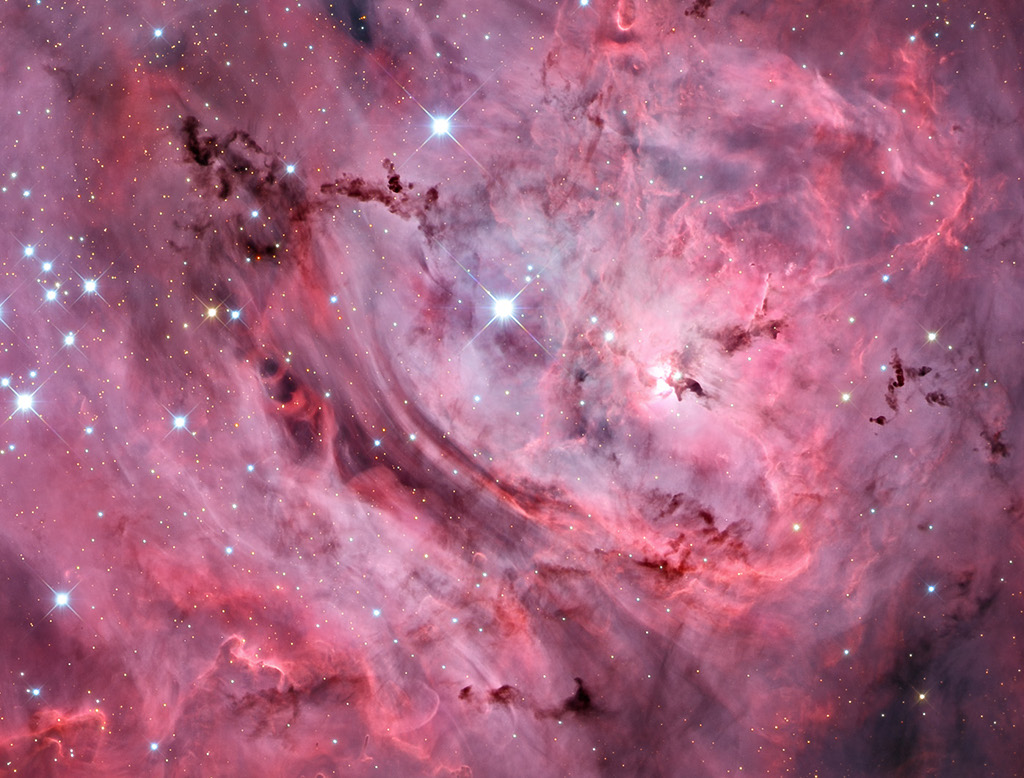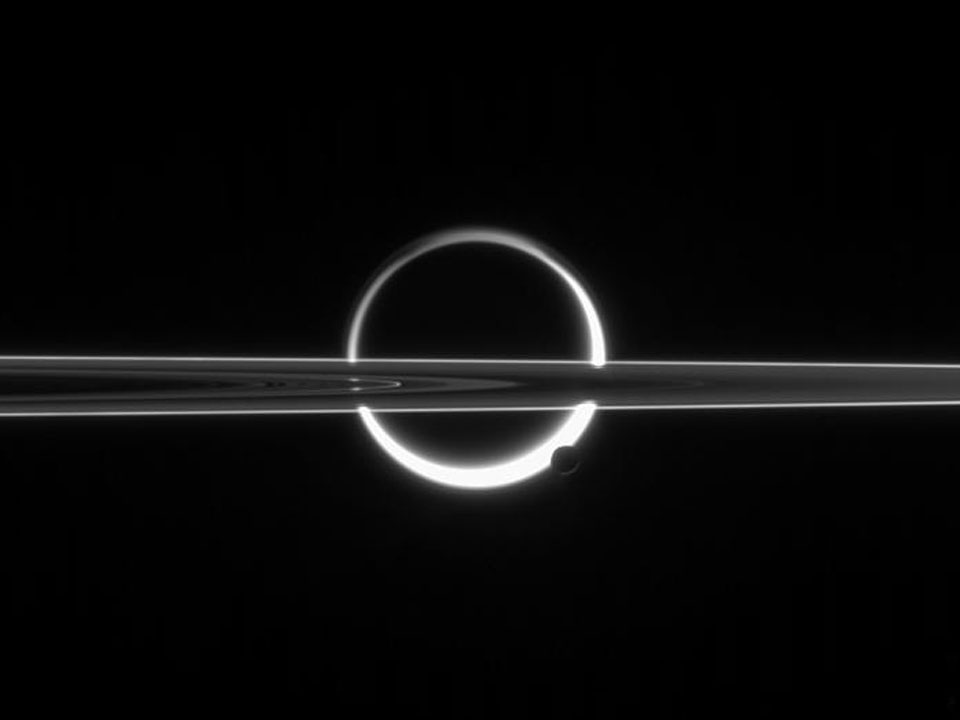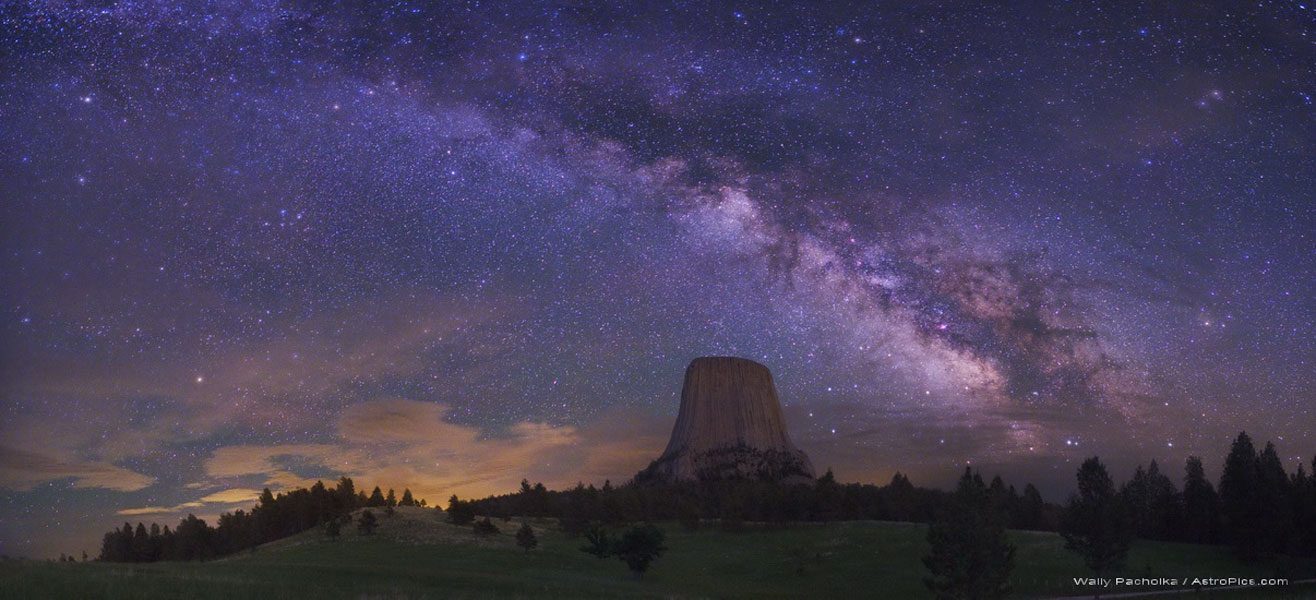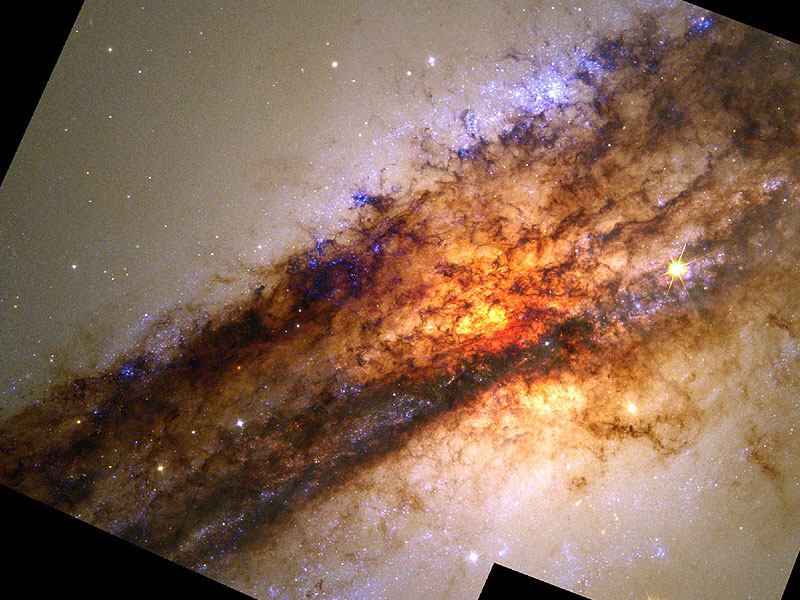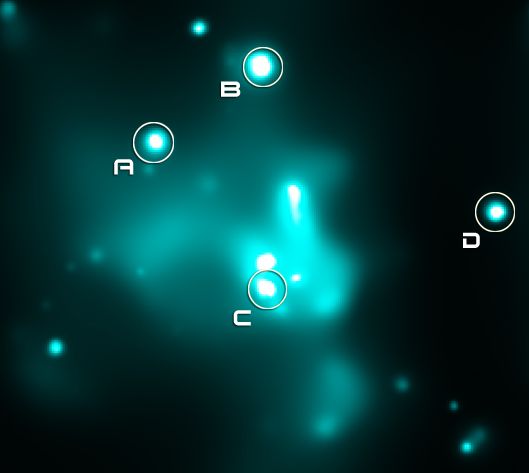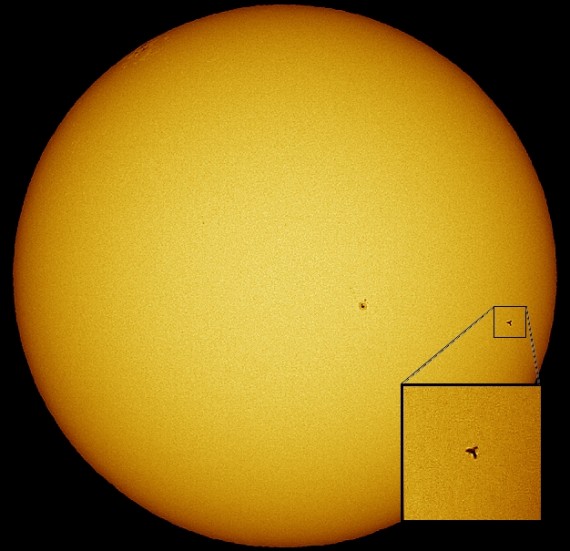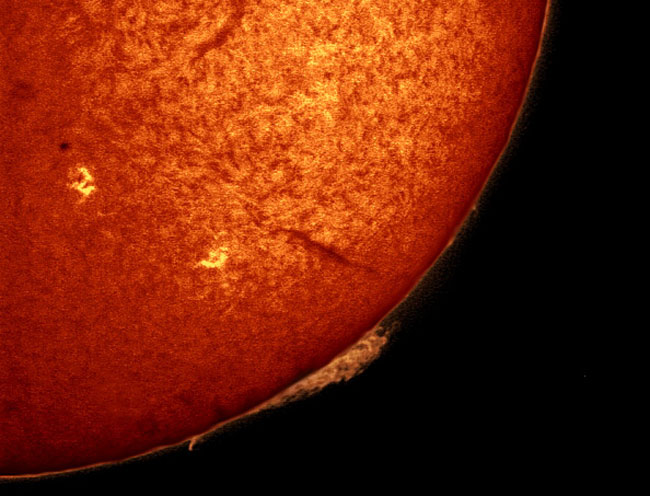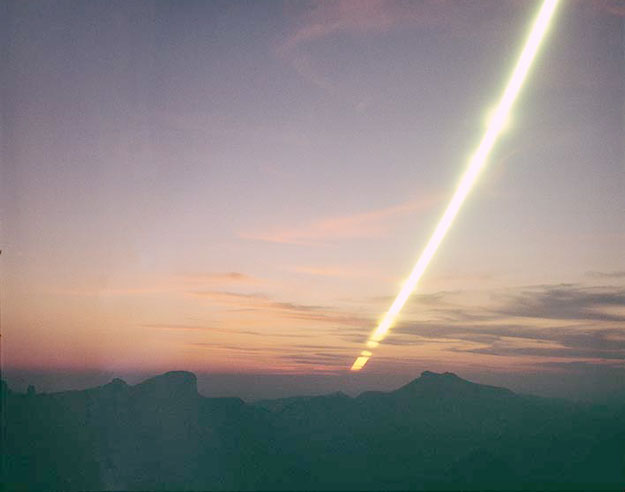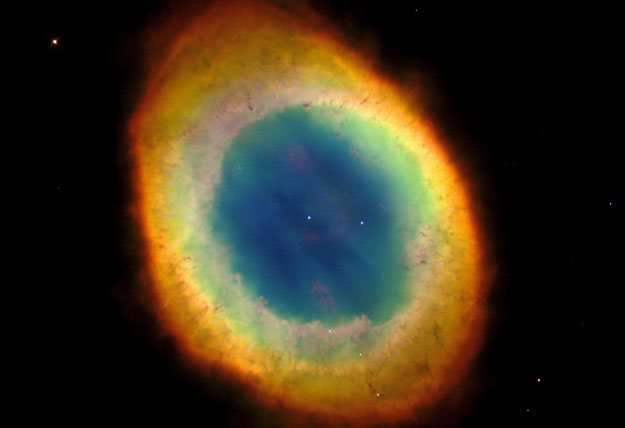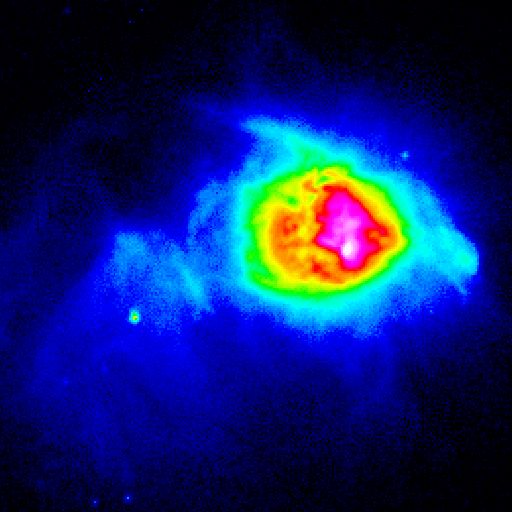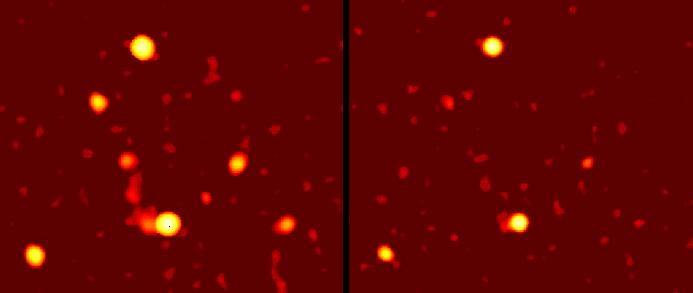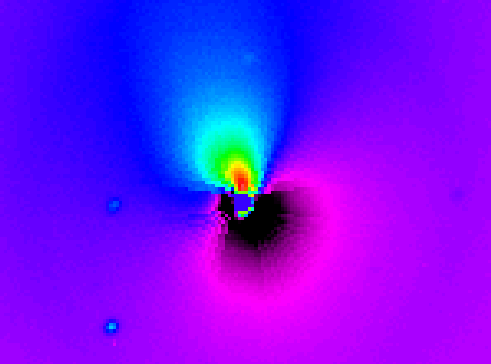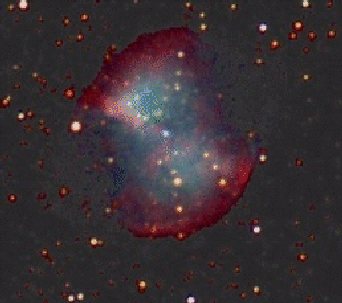| << Previous | Index | Next >> |
2015 Ridges of glowing interstellar gas and dark dust clouds inhabit the turbulent, cosmic depths of the Lagoon Nebula. Also known as M8, The bright star forming region is about 5,000 light-years distant. But it still makes for a popular stop on telescopic tours of the constellation Sagittarius, toward the center of our Milky Way Galaxy. Dominated by the telltale red emission of ionized hydrogen atoms recombining with stripped electrons, this stunning, deep view of the Lagoon's central reaches is about 40 light-years across. Near the center of the frame, the bright hourglass shape is gas ionized and sculpted by energetic radiation and extreme stellar winds from a massive young star.
2014 To some, it may look like a portal into the distant universe. To others, it may appear as the eye of a giant. Given poetic license, both are correct. Pictured above is a standard fisheye view of the sky -- but with an unusual projection. The view is from a perch in New Zealand called Te Mata Peak, a name that translates from the Maori language as "Sleeping Giant". The wondrous panorama shows the band of our Milky Way Galaxy right down the center of the sky, with the Large and Small Magellanic Clouds visible to the right. The red hue is atmospheric airglow that surprised the photographer as it was better captured by the camera than the eye. The above image was taken two weeks ago as the photographer's sister, on the left, and an acquaintance peered into the sky portal.
2013 This is not a solar eclipse. Pictured above is a busy vista of moons and rings taken at Saturn. The large circular object in the center of the image is Titan, the largest moon of Saturn and one of the most intriguing objects in the entire Solar System. The dark spot in the center is the main solid part of the moon. The bright surrounding ring is atmospheric haze above Titan, gas that is scattering sunlight to a camera operating onboard the robotic Cassini spacecraft. Cutting horizontally across the image are the rings of Saturn, seen nearly edge on. At the lower right of Titan is Enceladus, a small moon of Saturn. Since the image was taken pointing nearly at the Sun, the surfaces of Titan and Enceladus appear in silhouette, and the rings of Saturn appear similar to a photographic negative. Now if you look really really closely at Enceladus, you can see a hint of icy jets shooting out toward the bottom of the image. It is these jets that inspired future proposals to land on Enceladus, burrow into the ice, and search for signs of extraterrestrial life.
2012
2011 This sharp view from the Thermal Emission Imaging System camera on NASA's Mars Odyssey orbiter is centered on 154 kilometer (96 mile) wide Gale crater, near the martian equator. Within Gale, an impressive layered mountain rises about 5 kilometers (3 miles) above the crater floor. Layers and structures near its base are thought to have been formed in ancient times by water-carried sediments. In fact, a spot near the crater's northern side at the foot of the mountain has now been chosen as the target for the Mars Science Laboratory mission. Scheduled for launch late this year, the mission will land Mars' next visitor from planet Earth in August of 2012, lowering the car-sized Curiosity rover to the martian surface with a hovering, rocket-powered skycrane. Curiosity's science instruments are intended to discover if Gale once had favorable environmental conditions for supporting microbial life and for preserving clues about whether life ever existed on the Red Planet.
2010 From central Australia, this serene 360 degree panorama follows a clear horizon as twilight began on May 28. At left, a bright western sky is still illuminated by the setting Sun. But sweeping right, toward a view centered on the countryside's dominating sandstone formation called Uluru or Ayers Rock, the sky takes on progressively darker hues and subtle colors. Behind Uluru is the shadow of planet Earth itself, a dark blue arch rising in the east. Cast through the dense atmosphere and still close to the horizon, Earth's long shadow is bounded above by a pinkish glow or antitwilight arch. Known as the Belt of Venus, the lovely color of the antitwilight arch is due to backscattering of reddened light from the setting Sun. On that night, a nearly full Moon also rose above Earth's shadow in the eastern sky.
2009 Was Devils Tower once an explosive volcano? Famous for its appearance in films such as Close Encounters, the origin of Devil's Tower in Wyoming, USA is still debated, with a leading hypothesis holding that it is a hardened lava plume that probably never reached the surface to become a volcano. The lighter rock that once surrounded the dense volcanic neck has now eroded away, leaving the dramatic tower. High above, the central band of the Milky Way galaxy arches across the sky. Many notable sky objects are visible, including dark strands of the Pipe Nebula and the reddish Lagoon Nebula to the tower's right. Green grass and trees line the moonlit foreground, while clouds appear near the horizon to the tower's left. Unlike many other international landmarks, mountaineers are permitted to climb Devils Tower.
2008 Sometimes, after your eyes adapt to the dark, a spectacular sky appears. Such was the case earlier this month over Ontario, Canada, when part of a spectacular sky also became visible in a reflection off a lake. To start, the brightest objects visible are bright stars and the planet Jupiter, seen as the brightest spot on the upper left. A distant town appears as a diffuse glow over the horizon. More faint still, the disk of the Milky Way Galaxy becomes apparent as a dramatic diffuse band across the sky that seems to crash into the horizon far in the distance. In the foreground, a picturesque landscape includes trees, a lake, and a stone wall. Finally, on this serene night in July when the lake water was unusually calm, reflections appear. Visible in the lake are not only reflections of several bright stars, but part of the Milky Way band itself. Careful inspection of the image will reveal, however, that bright stars leave small trails in the lake reflections that do not appear in the sky above. The reason for this is because the above image is actually a digital composite of time-consecutive exposures from the same camera. In the first set of exposures, sky images were co-added with slight rotations to keep the stars in one place.
2007 A fantastic jumble of young blue star clusters, gigantic glowing gas clouds, and imposing dark dust lanes surrounds the central region of the active galaxy Centaurus A. This mosaic of Hubble Space Telescope images taken in blue, green, and red light has been processed to present a natural color picture of this cosmic maelstrom. Infrared images from the Hubble have also shown that hidden at the center of this activity are what seem to be disks of matter spiraling into a black hole with a billion times the mass of the Sun! Centaurus A itself is apparently the result of a collision of two galaxies and the left over debris is steadily being consumed by the black hole. Astronomers believe that such black hole central engines generate the radio, X-ray, and gamma-ray energy radiated by Centaurus A and other active galaxies. But for an active galaxy Centaurus A is close, a mere 10 million light-years away, and is a relatively convenient laboratory for exploring these powerful sources of energy.
2006 What do you call a group of black holes ... a flock, a brace, a swarm? Monitoring a region around the center of our Galaxy, astronomers have indeed found evidence for a surprisingly large number of variable x-ray sources - likely black holes or neutron stars in binary star systems - swarming around the Milky Way's own central supermassive black hole. Chandra Observatory combined x-ray image data from their monitoring program is shown above, with four variable sources circled and labeled A-D. While four sources may not make a swarm, these all lie within only three light-years of the central supermassive black hole known as Sgr A* (the bright source just above C). Their detection implies that a much larger concentration of black hole systems is present. Repeated gravitational interactions with other stars are thought to cause the black hole systems to spiral inward toward the Galactic Center region.
2005 That large sunspot near the right edge of the Sun is actually not a sunspot at all. It's the International Space Station (ISS) and the Space Shuttle Discovery on mission STS-114. In the past, many skygazers have spotted the space station and space shuttles as bright stars gliding through twilight skies, still glinting in the sunlight while orbiting 200 kilometers or so above the Earth's surface. But here, astronomer Anthony Ayiomamitis took advantage of a rarer opportunity to record the spacefaring combination moving quickly in silhouette across the solar disk. He snapped the picture on Thursday, July 28th from Athens, Greece. Launched on Tuesday, Discovery joined with the ISS Thursday, making the already large space station seem to loom even larger.
2004 Steep cliffs drop into the rugged terrain of Melas Chasma in this stunning view from the Mars Express spacecraft orbiting the Red Planet. At a scale of 16 meters per pixel, the image data from the orbiter's High Resolution Stereo Camera offers evidence that volcanic activity, water, wind erosion and marsquakes may all have shaped the region. Melas Chasma lies along the central southern edge of the large Valles Marineris, the grand canyon of Mars. While the Valles Marineris is itself over 4,000 kilometers long and up to 10 kilometers deep, the region pictured spans about 70 kilometers. The floor of Melas Chasma seen here is several kilometers below the surrounding plateau.
2003 Even a quiet Sun is a busy place. The above image, taken in a single color of light called Hydrogen Alpha, records a great amount of detail of the simmering surface of our parent star. The gradual darkening towards the Sun's edge, called limb darkening, is caused by increased absorption of relatively cool solar gas. Further over the edge, a giant prominence is visible, while a different prominence can be seen in silhouette as the dark streak near the image center. Two active areas of the Sun are marked by bright plages. The above amateur photograph of the Sun was taken just last month through a small telescope and a standard digital camera. In contrast, there are times when our Sun appears much more active.
2002 The Sun appears to move on the sky because the Earth rotates. The extreme brightness of the Sun, however, makes it difficult to capture a sun-trail -- the path the Sun traces on the sky. To capture the above picture, a very dark filter covered the camera lens for most of the time, allowing only a trifle of light from the bright Sun to peek through. Just after the Sun had dipped below the horizon but before it was completely dark, the thick filter was removed and the pretty foreground scene was captured. Slight flares appeared when the Sun went behind thin clouds. Star-trails and planet-trails are much easier to image, and a similar Moon trail has also recently been imaged.
2001 Except for the rings of Saturn, the Ring Nebula (M57) is probably the most famous celestial band. This planetary nebula's simple, graceful appearance is thought to be due to perspective -- our view from planet Earth looking straight into what is actually a barrel-shaped cloud of gas shrugged off by a dying central star. Astronomers of the Hubble Heritage Project produced this strikingly sharp image from Hubble Space Telescope observations using natural appearing colors to indicate the temperature of the stellar gas shroud. Hot blue gas near the energizing central star gives way to progressively cooler green and yellow gas at greater distances with the coolest red gas along the outer boundary. Dark, elongated structures can also be seen near the nebula's edge. The Ring Nebula is about one light-year across and 2,000 light-years away in the northern constellation Lyra.
2000 NGC1850 is a large cluster of stars located a mere 166,000 light-years from Earth in our neighboring galaxy the Large Magellanic Cloud (LMC). The colors in this beautiful Hubble Space Telescope composite image of the cluster reveal different populations of stars. Yellowish stars are the main cluster stars, sun-like main sequence hydrogen burners about 50 million years old. The white stars are massive, hotter, and younger, about 4 million years old. Radiating strongly in ultraviolet light, they represent a loose cluster themselves, perhaps within 200 light-years of the main cluster. Massive stars which formed in the older main cluster have long since disappeared, ending their lives in spectacular supernova explosions. Did expanding debris from these supernovae trigger the formation of the nearby younger cluster? Probably so. In any event, a few million years from now a similar fate awaits the massive stars of the younger cluster - burning brightly but briefly before they explode sending new clouds of stellar debris into space.
1999 The bright blob of hydrogen gas cataloged as N88A is seen at the right. It measures a mere 3 light years across. Emerging from the cool, dusty interstellar medium in a nearby irregular galaxy known as the Small Magellanic Cloud, N88A hides hot young stars at its core. The false-color Hubble Space Telescope image was recorded in the characteristic "H-alpha" light emitted by hydrogen atoms as they are ionized by the young star's energetic ultraviolet light and then recombine. Other regions of ionized hydrogen (H II regions) which surround new born stars can be over a thousand light-years across but astronomers now recognize that these small ionized hydrogen blobs contain some of the most massive stars known.
1998 These high resolution false color pictures of the Galactic center region in high energy X-ray and gamma-ray light result from a very long exposure of roughly 3,000 hours performed from 1990 to 1997 by the French SIGMA telescope onboard the Russian GRANAT spacecraft. Each image covers a 14x14 degree field which includes most of the central bulge of our Milky Way Galaxy. The X-ray picture (left) reveals a cluster of sources releasing enormous amounts of energy. They are probably binary star systems where matter accretes onto a collapsed object, either a neutron star or a black hole. But according to recent theories, only those binary systems with black holes can radiate above X-ray energies -- in the gamma-ray regime. In that case, the SIGMA sources also shining in the gamma-ray picture (right) betray the presence of accreting stellar black holes! Surprisingly, no high energy source seems to coincide exactly with the Galactic center itself, located near the brightest source at the bottom of both pictures. This indicates that the large black hole thought to be lurking there is unexpectedly quiet at these energies.
1997 The rocks on Mars tell us stories about their past. To decipher these stories, a scientist must become a detective, searching for clues and fitting them with theories. The above photograph of the rocky Martian surface to the northeast of Pathfinder's landing site provides many such clues. For example, at least three types of rocks are evident, marked with red, white and blue arrows. The red arrows point to smooth rocks, which Pathfinder scientists hypothesize have been eroded by tumbling through ancient channels of water which evaporated long ago. The blue arrows indicate a different type of rock, ragged ones with sharp edges, hypothesized to have been ejected when nearby craters formed or volcanoes erupted. The white areas are more mysterious, and might be some sort of composite material. Sojourner was recently diverted to study these white areas to gather more clues so continued detective work can yield better insight into the Martian past.
1996 Approaching the inner Solar System, comet Hale-Bopp's icy nucleus is heated by sunlight, accelerating its production of dust and gas. Shrouded in the resulting cloud, known as the coma, the cometary nucleus remains hidden from direct view. However, astronomers using a 2.2 meter telescope at the European Southern Observatory in May, were able to detect an enormous jet of dust extending northward (up) from the nuclear region as seen in this false color image. Dust jets may arise from vents on the surface of the nucleus. Early estimates of the size of Hale-Bopp's nucleus have indicated that it could be as large as 40 kilometers (24 miles) in diameter -- several times larger than comet Halley's. Hale-Bopp's copious dust production bodes well for it becoming a bright naked-eye comet in the spring of 1997.
1995 The Dumbbell Nebula is a beautiful red and blue planetary nebula in the constellation of Vulpecula. It is the 27th object on Charles Messier's list of diffuse sky objects, and so is referred to as M27. Its high surface brightness makes it a good target for small telescopes. The term planetary nebula, used to describe this general class of objects, is misleading. Although these objects may appear round and planet-like in small telescopes, astronomers have determined them to be stars surrounded by cocoons of gas blown off in the late stages of evolution.
| << Previous | Index | Next >> |
